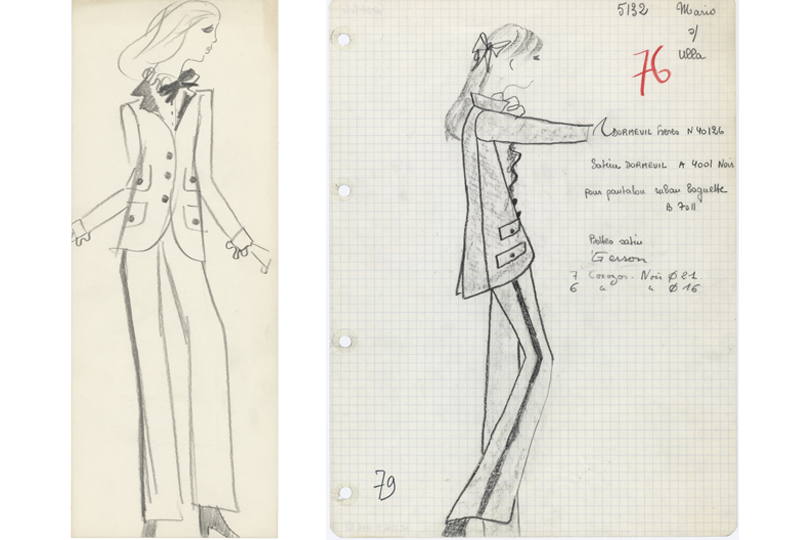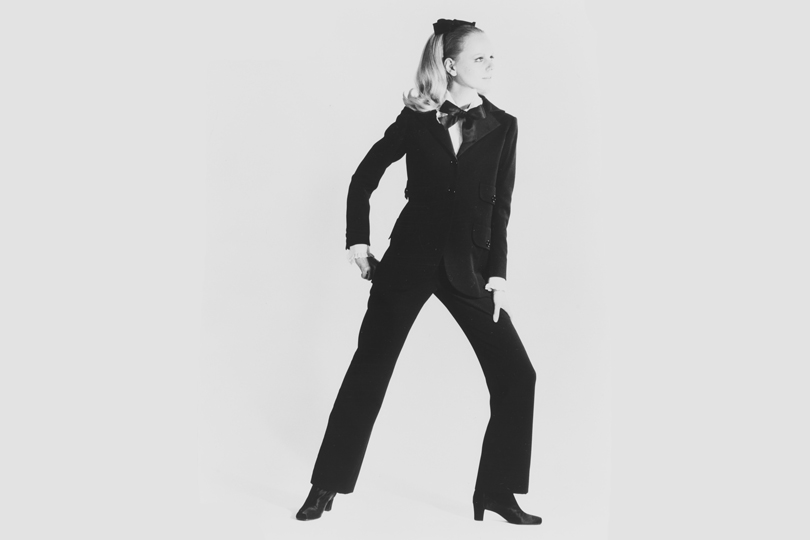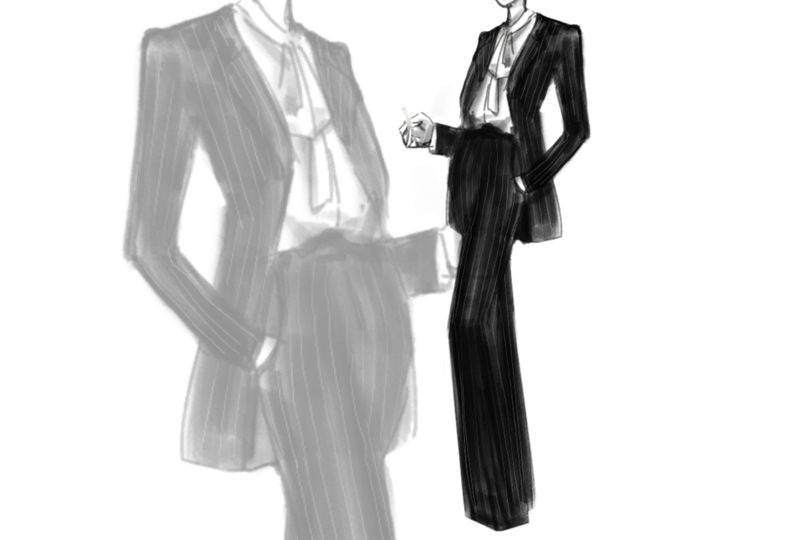Part of an ongoing series of 29Secrets stories, taking a deep dive into the history of legendary beauty products and iconic fashion moments…
By Christopher Turner
Illustration by Michael Hak
“Fashions fade, style is eternal.” You’re probably familiar with one of fashion’s most famous quotes, but did you know that the quote is attributed to the legendary French couturier Yves Saint Laurent, who was actually talking about one of his most famous creations? Le Smoking, the tuxedo suit he designed for women in 1966, would go on to pave the way for suiting for women throughout the decades. “For a woman, the tuxedo is an indispensable garment in which she will always feel in style,” said Mr. Saint Laurent in the lesser-known first part of the famous quote.
Le Smoking was the first of its kind, a ground-breaking tuxedo suit designed specifically for women that would go on to earn unprecedented attention in the fashion world and in broader popular culture. As Mr. Saint Laurent’s tuxedo was designed specifically for women, it differed greatly from the traditional tuxedo worn by men at the time. Most notably, the collar was more feminine, the shape and curve were more subtle, the waistline of the blouse was narrowed to show the body shape, and the pants were adjusted to help elongate the leg.
Le Smoking pioneered a shift in the way women dressed, introducing minimalist, androgynous styles for women, and inspiring power suits and the pantsuits worn by women in modern-day society. Endorsing its endurance and importance, Le Smoking has been endlessly referenced (and paid tribute to) by competing luxury fashion houses and designers around the world.
Intended to replace the usual elaborate party dresses of the time, Mr. Saint Laurent’s iconic Le Smoking suit officially made its controversial debut in the summer of 1966 as part of the designer’s eponymous fall/winter 1966/1967 haute couture collection – but the original idea of taking bits and pieces from both men’s suits and women’s clothing and combining them stemmed from the designer’s childhood hobby of designing outfits for his collection of paper dolls. Here’s the story of Yves Saint Laurent’s Le Smoking, one of the most enduring and powerful fashion creations of the last century.
Early iterations of what would become known as Le Smoking
Yves Henri Donat Matthieu-Saint-Laurent was born on August 1, 1936, in Oran, Algeria, to Charles and Lucienne Andrée Mathieu-Saint-Laurent. He grew up, relatively well off, in a Mediterranean villa with his two sisters, Michèle and Brigitte. Bullied by schoolmates for appearing to be homosexual, Mr. Saint Laurent was a nervous child who finally found solace in the world of fashion. At age 13, inspired by a performance of Molière’s School for Wives, he created his very own Illustre Petit Théâtre, a miniature, hand-painted stage set complete with 11 paper dolls, which he then created clothing and accessories for – some of which included fabric secretly snipped from his mother’s clothes. As a teenager, he began designing dresses for his mother and sisters, and continued designing for his collection of paper dolls.
At the age of 17, Mr. Saint Laurent’s mother took him to Paris to meet the editor of French Vogue, Michael de Brunhoff, and the following year, at the age of 18, he moved to Paris and enrolled at the Chambre Syndicale de la Haute Couture, where his designs quickly gained notice. In 1953, Mr. Saint Laurent submitted three sketches to a contest for young fashion designers organized by the International Wool Secretariat, and won first place, beating out future contemporaries Belgian designer Fernando Sánchez and German design student Karl Lagerfeld. Not long after the competition, on June 20, 1955, Saint Laurent met legendary French couturier Christian Dior, who was so impressed by the young man’s talent he immediately hired him as his first-ever (and only) head assistant.
“Dior fascinated me,” Mr. Saint Laurent later recalled. “I couldn’t speak in front of him. He taught me the basis of my art. Whatever was to happen next, I never forgot the years I spent at his side.”
As for the paper dolls…they were still around. By 1955, they had a reported wardrobe of 443 tiny outfits – including early iterations of what would later become known as Le Smoking.
Miniature designs in life-sized form
Mr. Saint Laurent learned the secrets of haute couture while working at the iconic house of Dior in Paris. When Mr. Dior unexpectedly died at the age of 52 of a massive heart attack on October 24, 1957, Mr. Saint Laurent found himself appointed the head designer of the House of Dior. He was only 21 years old.
Mr. Saint Laurent’s first collection for the brand, the spring 1958 collection, was called the Trapeze line, and it was filled with simple, flaring lines, a variation of Mr. Dior’s 1955 A-Line, which catapulted him to international stardom.
In 1960, Mr. Saint Laurent was called up to serve in the French army to fight against Algeria in its war for independence from France. Mr. Saint Laurent was in the military for a total of 20 days before the stress of hazing by fellow soldiers led to him being admitted to a military hospital. It was there he received the news that he had been fired from Dior after the completion of six collections and had been replaced by Marc Bohan, his former assistant. The designer was devastated and fell into a deep depression.
After his release from hospital in November 1960, Mr. Saint Laurent sued Dior for breach of contract; a court eventually awarded him 680,000 francs (about US$140,000 at the time). Less than a year later, in September 1961, Mr. Saint Laurent announced plans to open his own haute couture house – aptly named Yves Saint Laurent – in partnership with his lover, French industrialist Pierre Bergé.
The first Yves Saint Laurent collection was shown on January 19, 1962. It was the beginning of one of the most successful fashion houses in history, with Mr. Saint Laurent revolutionizing fashion and popularizing trends like the beatnik look, safari jackets for men and women, pea coats, tight pants, the jumpsuit, and thigh-high boots (via his friend shoe designer Roger Vivier).
Just five years after launching his namesake brand, Mr. Saint Laurent realized one of his most mesmerizing miniature paper doll designs in life-sized form, which would go on to become his most famous and important design (a style Mr. Saint Laurent reinterpreted many times over the years). The Le Smoking tuxedo suit for women was part of Yves Saint Laurent’s fall/winter 1966 “Pop Art” collection, presented in August in 1966 in Paris. Among the series of colourful dresses, he also rolled out Le Smoking, a black women’s suit comprising straight-legged pants, a white ruffled organza shirt, a bow tie, a wide satin belt and a tailored jacket.
Le Smoking roughly translates to ‘tuxedo’ in French, and Mr. Saint Laurent’s design was meant to pay homage to the precursor to men’s modern black tie. The original tuxedo was a silk-lapelled smoking jacket reserved only for men in the late 1800s; it was worn in a smoking room to protect a man’s clothing from the smell of cigars and protect his clothes from any falling ash.

Mr. Saint Laurent’s Le Smoking may have been inspired by a men’s tuxedo, but it was not an exact copy. He used the same codes but adapted it to the female body so it featured a gently tapered waist and feminine silhouette with a sleeker cut collar.
“A woman wearing a suit is anything but masculine,” said Mr. Saint Laurent. “A strict, clean cut accentuates her femininity, her seductiveness, her ambiguity.”
There are many aspects of Le Smoking’s origin story that aren’t exactly clear. Some fashion historians say that Mr. Saint Laurent was influenced by the androgynous style of Yves Saint Laurent model Danielle Luquet de Saint Germain – his long-time muse – while others assert that the designer was inspired by French artist Niki de Saint-Phalle, whose personal uniform at the time consisted of a man’s dress suit with a pair of heels. Marlene Dietrich was also an inspiration for the designer’s creation of Le Smoking.
“I was deeply struck by a photograph of Marlene Dietrich wearing men’s clothes,” the designer said. “A tuxedo, a blazer or a naval officer’s uniform – a woman dressed as a man must be at the height of femininity to fight against a costume that isn’t hers.”

Le Smoking ruffled more than a few feathers after its debut. “When Yves Saint Laurent’s smoking made its first appearance in an haute couture collection, it started a revolution. A man’s article of clothing thus became the symbol of female emancipation,” stated the press release for the 2005 “Smoking Forever” exhibition in Paris, which showcased the designer’s countless interpretations of the suit up throughout his career.
Speaking to the BBC, model and muse Violeta Sanchez explained that at the time, it was quite something for the stuffy bourgeois set to see women “take possession of man’s attire, and the freedom it gave her. It took her out of that spot where she was fragile.”
Le Smoking was certainly radical…a little too radical for a time when it was absolutely unheard of for a woman to wear trousers as evening wear. Fashion editors initially disapproved of it, seeing it as a disruption to traditional styles of the time, and considered it an outfit that caused gender confusion. The designer’s rich couture clientele agreed, and snubbed the “Pop Art” collection – in fact, only one Le Smoking tuxedo was actually sold.
It’s not that surprising, considering this was a time when French laws forbade women from wearing trousers in public (although this wasn’t necessarily enforced). When Danielle Luquet de Saint Germain borrowed the original Le Smoking in the summer of 1966 – mere weeks after it was presented in the “Pop Art” collection – the model was refused entry to a well-known casino in Normandy. The manager at the Plaza Hotel in Manhattan refused to serve women who wore Le Smoking, while in another noted incident, French singer-songwriter Françoise Hardy was heckled when she wore the Le Smoking to the opera in Paris.
“People screamed and hollered,” Mr. Saint Laurent told WWD in 2005. “It was an outrage.”
Mr. Saint Laurent wasn’t deterred by the negative response to his paper doll-inspired creation. In September 1966, less than two months after its debut, his snubbed Le Smoking was given another shot when he and Mr. Bergé opened a ready-to-wear boutique on Paris’s Left Bank and unveiled his more affordable – and aptly named – Saint Laurent Rive Gauche line, which included a lower-priced version of Le Smoking. This version was a huge success thanks to its lower price and the ready-to-wear label’s younger, more forward-thinking customers.

Le legacy
Despite all the controversy Le Smoking, with its sharply tailored minimalist lines, stuck around and forever changed the way womenswear was perceived, serving as the precursor to the power suit that would dominate decades later.
Mr. Saint Laurent would go on to include a version of Le Smoking in each of his collections until 2002, when his eponymous fashion label presented its final couture collection. He retired following the presentation and became increasingly reclusive until he died of brain cancer on June 1, 2008, at his residence in Paris.
After his death, Mr. Saint Laurent was hailed as the designer who defined the way 20th century women dressed, largely thanks to his most important creation, unanimously declared to be Le Smoking. His appropriation of men’s clothing not only created the 20th century woman’s androgynous look and shifted the direction of women’s fashion, it also expressed the essence of feminism.
“This was a radical change for professional women, who could wear a practical suit which also looked elegant,” wrote Mr. Saint Laurent’s long-time muse Bianca Jagger, speaking of the legacy of Le Smoking in her obituary for the designer in The Guardian. Jagger was no stranger to breaking sartorial codes herself; she wore a white Yves Saint Laurent Le Smoking jacket, which had debuted only four years earlier, with a matching white skirt when she married Rolling Stone frontman Mick Jagger in 1971 in Saint-Tropez. “To see his influence you just have to look at the women who now wear trouser suits, influenced by his classic designs – everyone from Hillary Clinton to [former] French justice minister Rachida Dati. It was part of my liberation to be able to wear trouser suits because it makes life so easy.”
Today, Le Smoking is still a name closely associated with the Yves Saint Laurent brand. When Hedi Slimane took over as creative director at the French fashion house in 2012, he brought the silhouette back, and so has Anthony Vaccarello, the Belgian-Italian fashion designer who is the current creative director of Yves Saint Laurent.
So, Le Smoking was Mr. Saint Laurent’s gift to fashion: pant suits, cut on men’s lines but to a female silhouette. Speaking of the tuxedo and what it meant at the time to women, Mr. Saint Laurent’s partner, Mr. Bergé expressed: “If Gabrielle Chanel brings women to freedom, Yves Saint Laurent gives women freedom – gives them power.” But, perhaps Mr. Saint Laurent put it best in 1982: “I do classic things for women to have the same assurance with their clothes that men have with theirs.”
In that case, Le Smoking forever.
![]()
Want more? You can read other stories from our The Story Of series right here.











